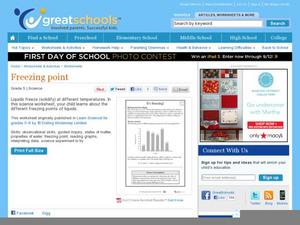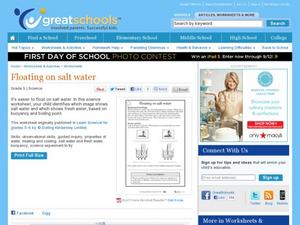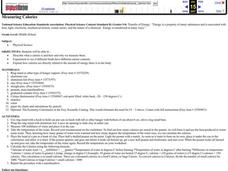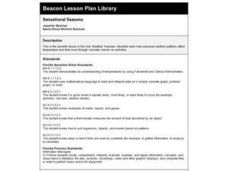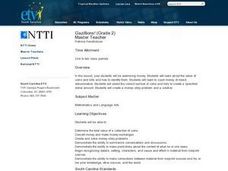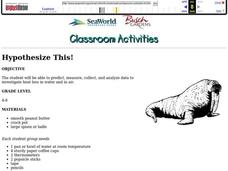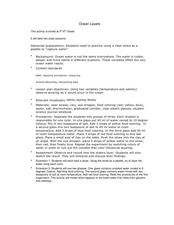Curated OER
It's About Time!
Students examine concept of time, and explore difference between analog and digital clocks; students make art project to represent time and create a time-story problem and solution.
Curated OER
It's Freezing!
Here is a good activity for 5th grade scientists. In it, they look at a bar graph that shows the freezing point for a variety of liquids. Then, they are given a scenario of a certain liquid melting and freezing, and must determine which...
Curated OER
Measuring Temperatures
Fourth graders participate in a teacher-led discussion about temperature--hot and cold. Each group of students is assigned specific materials for their lab experiment. They record temperatures measured in their journals and then plot...
Curated OER
Floating on Salt Water
Mixing substances together causes their properties to change. This resource illustrates that concept for fifth graders by having them consider four questions that have to do with buoyancy and boiling point. Learners begin to understand...
Curated OER
Measuring Calories
Learners investigate what a calorie is and how and why we measure them. They conduct an experiment to compare the calories of a peanut and a mini-marshmallow, and explain and discuss how calories are directly related to the amount of...
Curated OER
Measuring Calories
Students burn peanuts and marshmallows to determine the calories each contains. In this calorimetry lesson, students set up an apparatus with a ring stand and water in an aluminum can. They record the temperature of the water before and...
Curated OER
Sensational Seasons
Second graders explore how seasonal weather patterns affect temperature and their lives.
Curated OER
Bing! Bang! Boom!
Sixth graders investigate heat energy, conduction, convection, and radiation.
Curated OER
Earth Systems
Ninth graders investigate biological systems. They summarize relationships between systems. Students determine how systems relate within the biosphere. They analyze the carbon cycle.
Curated OER
Our Desert Backyard
Students make observations of their own backyard. In this environment lesson, students keep records of the plants and animals they see in their home or school yard. Students make notes of how the weather and environment changes over...
Curated OER
Record the Data and Find the Averages
Pupils record the daily outdoor temperature as well as the number of minutes of sunlight per day over a determined period. They calculate the average temperature and minutes of sunlight per day and post their data on the project website.
Curated OER
How the Amount of Solar Energy Absorbed by the Earth is Dependent Upon the Earth's Position
Students investigate the angle of light and how it faces the earth. They conduct a series of investigations with the following two objectives. Students determine if the angle of light is a factor in the absorption of heat. They correlate...
Curated OER
What is a Cloud
Third graders study clouds and how they are formed. They write acrostic poems about clouds and analyze and graph temperature data collected during varying degrees of cloud cover.
Curated OER
Gazillions!
Second graders determine the total value of a collection of coins. They convert money and make money exchanges. Students create and solve money-story problems. They demonstrate the ability to summarize conversations and discussions.
Curated OER
The Pressure's Off
Students investigate air pressure with four hands-on activities. They observe experiments by viewing Take a Look 2 #21.
Curated OER
HYPOTHESIZE THIS!
Students predict, measure, collect, and analyze data to investigate heat loss in water and in air.
Curated OER
When You're Hot, You're Hot!
Eighth graders examine the development of the different temperature scales. They experiment with hot and cold temperatures.
Curated OER
Ocean Layers
Students investigate how temperature and salinity causes ocean layering. In this ecology lesson, students observe and sketch their experimental result. They report their findings in class.
Curated OER
Demonstration of Factors Affecting Soil Temperature
Learners examine the influences of water and mulch on soil temperature. For this investigative activity students complete a soil experiment.
Curated OER
Temperature and Negative Numbers
In this intermediate temperature and negative numbers worksheet, students respond to 5 short answer questions regarding temperature.
Curated OER
Endothermic or Exothermic That Is the Question
Students conduct an experiment to determine what happens to heat energy during a chemical reaction. They examine an endothermic reaction by observing a chemical reactions.
Curated OER
What Is the Freezing Point?
Students remove heat energy and determine how it causes a phase change.
Science Struck
Science Struck: Types of Thermometers
Learn about the different types of thermometers, their applications, and how they work.



